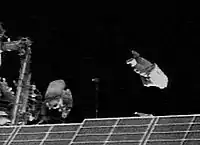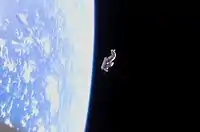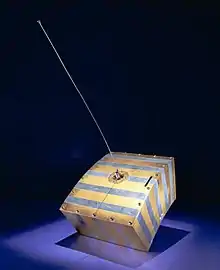SuitSat
SuitSat (also known as Mr. Smith, Ivan Ivanovich, RadioSkaf, Radio Sputnik and AMSAT-OSCAR 54) was a retired Russian Orlan spacesuit with a radio transmitter mounted on its helmet. SuitSat-1 was deployed in an ephemeral orbit around the Earth on February 3, 2006. The idea for this novel OSCAR satellite was first formally discussed at an AMSAT symposium in October 2004, although the ARISS-Russia team is credited with coming up with the idea as a commemorative gesture for the 175th anniversary of the Moscow State Technical University.



"SuitSat is a Russian brainstorm," according to Frank Bauer of NASA's Goddard Space Flight Center. "Some of our Russian partners in the ISS program, mainly a group led by Sergey Samburov, had an idea: Maybe we can turn old spacesuits into useful satellites." SuitSat is a first test of that idea.[1]
SuitSat-1
In a move originally planned for December 6, 2005, SuitSat-1 entered its own independent orbit just after 23:05 UTC on February 3, 2006 when it was taken on a spacewalk from the International Space Station by Valeri Tokarev and Bill McArthur as part of an unrelated spacewalk. Voice messages recorded by the teams involved, and by students from around the globe, were continuously broadcast in a number of languages from the SuitSat, along with telemetry data. The signal began transmission approximately 15 minutes after SuitSat-1 was jettisoned and was relayed by equipment on board the ISS. Anyone receiving the transmission could log an entry on the tracker at suitsat.org, detailing when and where they heard it.
However, the SuitSat-1 mission was not a total success. There were very few reports that actually confirmed the receiving of the transmission. NASA TV later announced that SuitSat ceased functioning after only two orbits due to battery failure, but there were reports suggesting that SuitSat-1 continued transmitting, though far weaker than expected.
The official designation for SuitSat is AMSAT-OSCAR 54, though it was nicknamed "Ivan Ivanovich" or "Mr. Smith". The radio transmitter used a frequency of 145.990 MHz.
The last confirmed signal report from SuitSat-1 was the report of KC7GZC on February 18, 2006. All later reports indicate that no signal was received when SuitSat-1 was due to pass over.
On September 7, 2006, at 16:00 GMT, Suitsat re-entered the Earth's atmosphere over the Southern Ocean at 110.4° East longitude and 46.3° South latitude. It was over a point some 1400 km south-southwest of Cape Leeuwin, Western Australia.[2]
ARISSat-1 (formerly SuitSat-2)
ARISSat-1 (SuitSat-2) was another ISS hand launched satellite. It contained experiments built by students and a software defined radio capable of supporting a U/v linear transponder, FM telemetry, voice recordings and live SSTV imagery. Unlike SuitSat-1, batteries on ARISSat-1 were charged by solar panels, and had a predicted lifetime up to six months (an interval during which it was expected to deorbit). Kedr was deployed from the ISS by Sergey Volkov on 3 August 2011,[3] and re-entered Earth's atmosphere in January 2012[4] having spent 154 days in orbit.
References
- http://www.nasa.gov/mission_pages/station/expeditions/expedition12/26jan_suitsat.html
- SuitSat entry at Heavens-Above.com Archived 2007-09-30 at the Wayback Machine
- ARISSat-1 Finally Deployed from ISS, ARRL, August 3, 2011, retrieved 2011-08-05
- "ArisSat-1 SK". Retrieved 4 January 2012.
External links
- Microchip in Space - NASA Releases SuitSat-1 with PIC18 Microcontroller
- AMSAT satellite detail
- suitsat.org
- Russian site about SuitSat satellite series
- SuitSat Audio Recordings and Updates - AJ3U.com
- NASA press release: "SuitSat: Using a simple police scanner or ham radio, you can listen to a disembodied spacesuit circling Earth."
- NASA Releases SuitSat 1 includes video and technical details
- "SuitSat-2 Now Called ARISSat-1"

